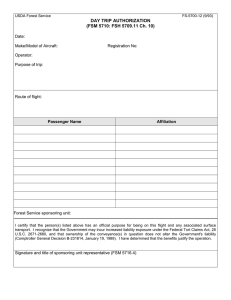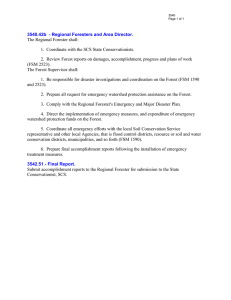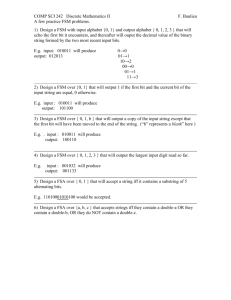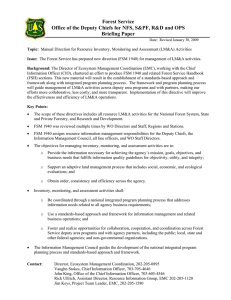APPENDIX L N R P
advertisement
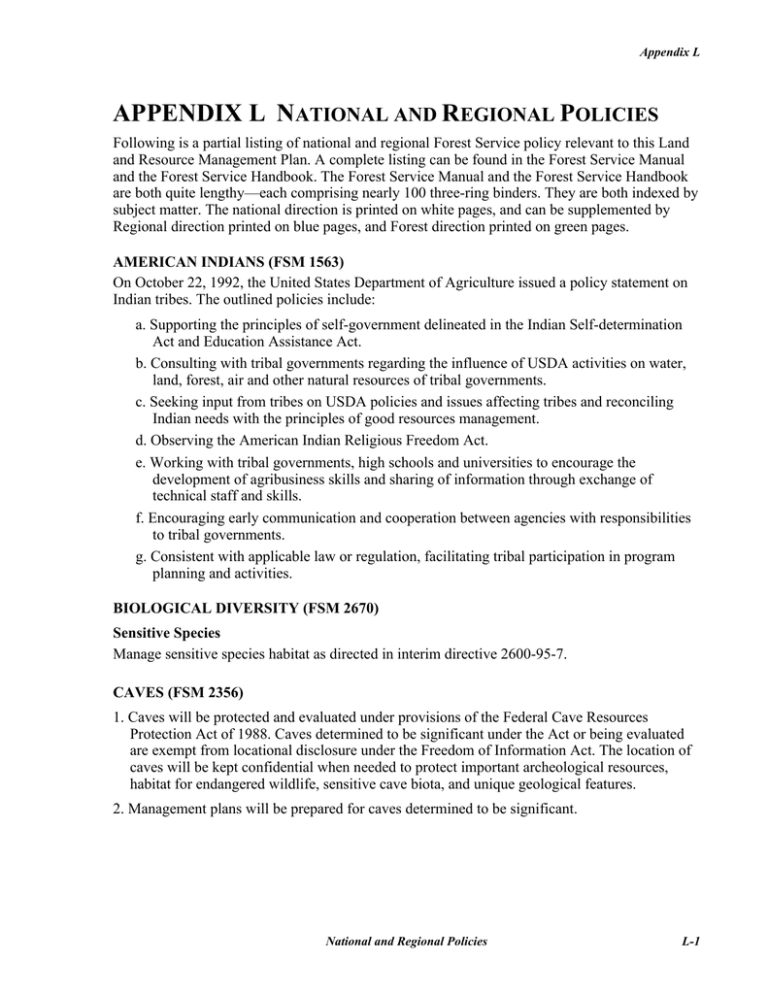
Appendix L APPENDIX L NATIONAL AND REGIONAL POLICIES Following is a partial listing of national and regional Forest Service policy relevant to this Land and Resource Management Plan. A complete listing can be found in the Forest Service Manual and the Forest Service Handbook. The Forest Service Manual and the Forest Service Handbook are both quite lengthy—each comprising nearly 100 three-ring binders. They are both indexed by subject matter. The national direction is printed on white pages, and can be supplemented by Regional direction printed on blue pages, and Forest direction printed on green pages. AMERICAN INDIANS (FSM 1563) On October 22, 1992, the United States Department of Agriculture issued a policy statement on Indian tribes. The outlined policies include: a. Supporting the principles of self-government delineated in the Indian Self-determination Act and Education Assistance Act. b. Consulting with tribal governments regarding the influence of USDA activities on water, land, forest, air and other natural resources of tribal governments. c. Seeking input from tribes on USDA policies and issues affecting tribes and reconciling Indian needs with the principles of good resources management. d. Observing the American Indian Religious Freedom Act. e. Working with tribal governments, high schools and universities to encourage the development of agribusiness skills and sharing of information through exchange of technical staff and skills. f. Encouraging early communication and cooperation between agencies with responsibilities to tribal governments. g. Consistent with applicable law or regulation, facilitating tribal participation in program planning and activities. BIOLOGICAL DIVERSITY (FSM 2670) Sensitive Species Manage sensitive species habitat as directed in interim directive 2600-95-7. CAVES (FSM 2356) 1. Caves will be protected and evaluated under provisions of the Federal Cave Resources Protection Act of 1988. Caves determined to be significant under the Act or being evaluated are exempt from locational disclosure under the Freedom of Information Act. The location of caves will be kept confidential when needed to protect important archeological resources, habitat for endangered wildlife, sensitive cave biota, and unique geological features. 2. Management plans will be prepared for caves determined to be significant. National and Regional Policies L-1 Appendix L 3. Coordinate the management of cave and surface resources. a. Manage the cave resource in partnership with caving organizations, other governmental agencies, scientists, researchers, and outdoor recreationists. b. Interpret cave resources and provide public evaluation for increased public understanding and awareness of the need to protect and preserve these unique ecosystems. c. Provide for public health and safety while recognizing that no cave is completely safe and that risk-taking is part of the caving experience. 4. Adjust silvicultural prescriptions to protect caves. a. Retain a vegetative buffer area around cave entrances. b. Do not alter cave entrances with timber harvest activities. c. Do not dispose of slash, refuse, or burn slash at cave entrances. 5. Road or trail signs should not direct public attention to wild caves. 6. Access for exploration and development of locatable mineral resources will be analyzed in response to a proposed operating plan. 7. Potential impacts to cave resources will be considered in reviewing any project.? 8. The water, sediment, nutrient and temperature regimes of caves and karst features will be protected so these environments can function naturally. DAMS (FSM 7500) 1. For administrative Class A, B, C and high hazard Class D dams located on National Forest System lands, annually update the National Inventory of Dams (PL99-662) in accordance with data elements required by the Federal Emergency Management Agency (FSM 7514). 2. Maintain a record for all dams on National Forest System lands over six feet high (vertical difference between the lowest point on the crest of the dam and the lowest point in the original stream bed). As a minimum, the record should include the dam identification, location, purpose, owner, administrative classification, hazard-potential classification, height, and maximum storage (FSM 7514). FIRE AND FUELS (FSM 5100) Fire Suppression 1. Structural firefighting is the responsibility of local fire service agencies. Structural fire protection from advancing wildfire within the National Forest and Grassland Protection Boundary is the responsibility of local fire service agencies and the Forest Service (FSM 5138.1). Fuel Treatment 2. Cooperate with state and local governments and fire protection districts in the development of fire hazard reduction plans and ordinances by providing technical assistance (FSM 3172, 3173, 3174). L-2 National and Regional Policies Appendix L 3. Provide a level of protection from wildfire outside of incorporated towns that minimizes the risk of building damage or firefighter exposure. A fire management plan will be written for all facilities on National Forest and Grassland lands and will be maintained in the Forest's and Grassland Fire Management Action Plan. National Fire Protection Association (NFPA) standards will be used as guidelines for the development of individual plans. Each plan will provide guidance for structural, vegetative, and infrastructure management of the facilities on the Forest and Grassland. Planning standards will be used to provide guidance for private landowners requesting direction for wildland fire-protection improvements. Prescribed Fire 4. Use prescribed fire to accomplish resource management objectives, such as reducing fuel load buildup, wildlife habitat improvement, etc. Identify objectives in conjunction with a burning plan approved by a line officer. Prescribed burns adjoining private or other federal or state lands will be coordinated with the adjoining landowner?(FSM 5140). 5. Use prescribed fire where it will meet management objectives in the most economically and ecologically acceptable way (FSM 5140). GEOLOGY (FSM 2800) 1. Permit appropriate prospecting and collecting proposals for fossils and minerals by noncommercial, scientific, and/or educational institutions, and provide appropriate opportunities for recreational collection of mineral and fossil materials, where consistent with Forest Plan goals and objectives (FSM 2860.3). 2. Prevent unauthorized removal of fossil and mineral resources (FSM 5302). 3. Propose significant paleontologic sites for designation as special interest areas or geologic areas?(FSM 2360, 2372, 4063). 4. Identify special geologic hazards and problems that affect land and resource management and encourage research in those areas (FSM 2880, 2883, 2884). HERITAGE RESOURCES (FSM 2360) Locate, evaluate, protect and foster public use and enjoyment of heritage resources. a. Protect all heritage resources listed on or eligible for the National Register of Historic Places (NRHP). b. Nominate all eligible heritage resources to the NRHP. c. All projects will be reviewed by a Forest Service professional heritage resources specialist for complete heritage resource inventories, evaluations and mitigation measures for a project's area of potential effect prior to issuing environmental decision notices (FSM 2361). d. Avoid effects to heritage resources until evaluated and determined ineligible for the NRHP. e. Implement appropriate mitigative measures in consultation with the State Historic Preservation Officer (SHPO) and/or the President's Advisory Council on Historic Preservation (ACHP) when eligible heritage resources will be affected. f. Maintain, stabilize, or enhance all eligible heritage resources. National and Regional Policies L-3 Appendix L INTEGRATED PEST MANAGEMENT (FSM 4500) Use only chemicals registered with the Environmental Protection Agency and follow label instructions. LANDS (FSM 5400) Landownership Adjustments 1. Work with other federal agencies to consolidate ownership and propose jurisdictional transfers that achieve the following objectives: a. Develop more effective and efficient work units. b. Reduce administrative costs. c. Improve, maintain and simplify user access to public lands. 2. Adjust National Forest System and private lands to create a landownership pattern that meets objectives of the Forest Service and other landowners. 3. Manage National Forest System lands identified for exchange or sale consistent with surrounding management area goals and in accordance with the following: a. Terminate special-use permits on an opportunity basis and in compliance with applicable regulations and Forest Service policy. b. Renew or extend special-use permits on an annual basis only with specific notice of the potential sale or exchange included in the authorization. c. Do not authorize construction of additional permanent facilities. d. Do not adversely affect land values by management activities. e. Do not adversely affect land values through issuance of special-use permits. f. Acquire unrestricted rights-of-way whenever possible to maintain the value of the public land. g. Ensure needed public rights-of-way are retained across all lands conveyed out of public ownership (FSM 5403.1). 4. Convey lands only if: a. Flood hazards on and downstream from conveyed lands are not increased. b. Natural and beneficial values of acquired wetlands equal or exceed those of conveyed wetlands. c. Natural water regimes in wetlands downstream from conveyed lands are not disrupted. d. Lands have been evaluated for the presence of hazardous materials and known hazardous materials have been removed. e. Lands do not contain habitat identified by the U.S. Fish and Wildlife Service as necessary for recovery of federally listed threatened and endangered species. f. Lands do not contain unique resource characteristics (FSH 5409.13, Chapter 30). L-4 National and Regional Policies Appendix L 5. Effect jurisdictional transfers that achieve the following objectives: a. Reduce duplication of efforts by users and agencies in terms of time, cost and coordination. b. Improve or maintain user access to the administrating agency. c. Decrease travel and enhance management. d. Improve public understanding of applicable laws, regulations, policies and procedures. e. Develop more effective and efficient work units. Property Boundary Administration (FSM 7150) 6. Locate, mark and post landlines according to the following priorities: a. Lines needed to meet planned activities; b. Lines needed to protect NFS lands from encroachment, and c. All other lines (FSM 7152). MINERALS (FSM 2800) General 1. Require an operating plan for each significant proposed mineral action that may disturb surface resources (FSM 2817, 2818, 2820). 2. In areas of active, producing sites or areas containing known reserves, consider only surface resource programs compatible with mineral activities. 3. Provide reasonable access to outstanding and reserved mineral rights (FSM 2830.5). 4. In designated Wilderness areas, provide for reasonable access to proposed operations and for restoration of disturbed lands as near as practical to their natural condition when they are no longer needed for operation. 5. Consider significant cave discoveries for mineral withdrawal and other protection measures (FSM 2761, 5302). 6. Deny drilling, mining or production on withdrawn lands, with the exception of valid existing rights at the time of withdrawal (FSM 2811, 2818). 7. Resolve suspected abuse of the mining laws such as occupancy of the land for purposes other than prospecting, mining and related operations. 8. Avoid placing or proposing capital investments or other surface resource activities in areas where they would interfere with operating sites or known mineral resources (FSM 2761). 9. Request mineral leasing withdrawals in situations, such as for classified lands. 10. Cover mining activity by an operating plan and performance bond of the appropriate amount. 11. Reclamation will return disturbed lands to the planned uses. National and Regional Policies L-5 Appendix L Leasable Minerals 12. Approve Surface Use Plan of Operation (36 CFR 228.107) in conformance with all stipulations included in the lease and necessary conditions of approval determined during review of the applications (FSM 2800). Geophysical Operations 13. Permit geophysical operations on withdrawn, classified lands where the operations do not interfere with purposes for which the lands are withdrawn. Do not permit such operations if significant adverse effects cannot be prevented (FSM 2860). Coal, Uranium and Non-Energy Common Materials 14. In designated Wilderness, Congressionally designated Wilderness study areas, and areas recommended for Wilderness in RARE II upon which Congress has not taken final action: a. Prospecting for and disposals of common varieties of mineral materials will not be authorized. b. Coal mining in the National Wilderness Preservation System is prohibited by the Coal Leasing Amendments Act of 1975. c. Unless there is statutory language to the contrary, in which case the statutory provisions control, recommend, or consent to BLM for issuance of leases or permits where operations, including surface-based access, product transportation and other necessary ancillary facilities, will not cause irreversible and irretrievable damage to surface resources and where the lands disturbed can be restored as near as practical to natural conditions. 15. In classified lands other than Wilderness (Wild and Scenic River Systems, RARE II Further Planning areas, National Recreation Areas, National Historic Sites, Natural Areas, Special Areas: such as geological, scenic and zoological, and some other specific classifications): a. Authorize common variety exploration and disposals under terms and conditions to protect the purposes for which the lands were classified. The objective of reclamation requirements will be to return lands to a condition suitable for the purposes for which they were classified. For special areas classified under 36 CFR 294 and 251.23 for specific management purposes, the regulatory provisions permit no use or occupancy inconsistent with the classification. b. Coal mining is prohibited by the Coal Leasing Amendment Act of 1975, within the National System of Trails and the Wild and Scenic Rivers System, including study rivers designated by that Act. c. Recommend or consent to BLM for issuance of leases, permits or licenses only when terms and conditions can be applied that will protect the purposes for which the lands were classified. L-6 National and Regional Policies Appendix L RANGE (FSM 2200) 1. Allotment management plans (AMPs) need to provide for threatened, endangered and sensitive species?(FSM 2203, 2211, 2212). 2. When updating AMPs, display forage utilization factors by type of management, the season of use, and the ecological type by condition and seral stage within the AMP?(FSM 2210, 2211). 3. Construct structural improvements to maintain or improve rangeland conditions within classified Wilderness, consistent with Wilderness values?(FSM 2323.26). 4. Riparian utilization or stubble-remaining standards are to be developed and included in AMPs. Consider season of use to minimize impacts on riparian zones?(FSM 2211, 2212, 2526). 5. Give emphasis to developing livestock management strategies that are economically efficient, environmentally sound and compatible with other resources?(FSM 2212.03 - 2212.8). 6. Structural and non-structural improvements to maintain or improve rangeland conditions will be designed to benefit livestock and wildlife and minimize impacts on wildlife and recreation users (FSM 2240). RECREATION (FSM 2300) Developed 1. Where terrain allows and demand exists, facilities will be considered for development to accommodate people with disabilities. Different challenge levels will be planned, depending upon the nature of the improvement and the principal form of recreation being provided. 2. The customer will be recognized as a spectrum of our society interested in a wide array of dispersed, sedentary, adventure, developed, guided, self- determined, motorized and nonmotorized activities in controlled and uncontrolled environments. Potential customers will be recognized as those who might use National Forest resources if appropriate services and resources were available (FSM 2330) 3. Sites will be managed and maintained according to the needs of our customers using the site. Safety and cleanliness are of utmost importance. Remove hazardous and/or dead trees in developed sites (FSM 2331 R-2 Supplement 2300-93-6, FSM 2332). 4. The type and level of development sophistication in developed sites may vary, depending upon the situation and need. They are developed by the Forest Service, concessionaires or cooperators and may be managed by any or a mix of these (FSM 2303). Recreation Opportunity Spectrum 5. A recreation opportunity spectrum (ROS) table is included in Chapter 1 of this Forest Plan. A decision to change an ROS class will be documented in a NEPA decision document (FSM 1922.15, 2310.3). National and Regional Policies L-7 Appendix L RESEARCH NATURAL AREAS (FSM 4060) 1. Discourage or prohibit any public use that contributes to impairment of research or natural values (FSM 4063.02,4063.3). 2. Use special-use permits or cooperative agreements to authorize and document scientific activity (FSM 4063.3). RIGHTS-OF-WAY (FSM 5460) Acquisition 1. Acquire rights-of-way on existing and proposed Forest System roads and trails that cross other than National Forest System lands. 2. Acquire rights-of-way using the following criteria: a. Legal access for existing roads and trails that provide general access to the National Forest. b. Legal access to support planned projects and high priority activities at least two years prior to project implementation (FSM 5461.2). SOILS (FSM 2550) 1. Soil should not be displaced more than a continuous area of 100 square feet or more (FSH 2509.18 R-2 Supplement). 2. Soils should not be compacted more than (FSH 2509.18 R-2 Supplement): a. A 15 percent increase in bulk density from the average undisturbed density, or b. Bulk density values that exceed the following threshold values: 1.25g/cc - silt and clay 1.30 g/cc - silty clay, silty clay loam and silt loam 1.40 g/cc - loam and clay loam 1.50 g/cc - sandy loam, sandy clay loam and sandy clay 1.60 g/cc - sand and loamy sand 3. Maintain adequate plant cover to protect the watershed and maintain plant health consistent with the soil type. 4. Management practices will be designed and implemented to maintain or improve the longterm soil productivity potential of the National Forest (FSH 2509.18 R-2 Supplement). 5. Soil quality monitoring will be conducted to determine if soil management goals, objectives and standards are being achieved (FSH 2509.18 R-2 Supplement). 6. Monitoring results will be used to adjust management activities and mitigating measures where necessary to prevent significant impairment of the long-term soil productivity (FSH 2509.18 R-2 Supplement). L-8 National and Regional Policies Appendix L SPECIAL LAND USES (FSM 2700) 1. Act on special-use applications according to the following priorities: a. Those required by law or regulation, or national in scope. b. Those in the public interest, mainly local or regional in nature. c. All others. 2. Do not approve any special-use applications that can be reasonably met on non-federal ?or other federal lands unless it is clearly in the public interest (FSM 2703.2). 3. Do not approve special-use applications for areas adjacent to developed sites unless the proposed use is compatible with the purpose and use of the developed site. 4. Utilize approved electronic sites where feasible. 5. Do not approve applications for use of federal land that involve any hazardous materials as defined in U.S.C. 9601 et seq., 40 CFR 261.30 and 40 CFR 302.4. The hazardous materials listed are individual chemicals. These references do not relate to hazardous waste dumps (FSM 2703). TIMBER (FSM 2400) General 1. Forests are to be managed to provide net public benefits. Many different philosophies and strategies are used that provide benefits desired in the areas of urban interface, those areas used for recreation and viewing, for wildlife habitat, watershed protection, water-yield enhancement, and others, as well as for wood and fiber products. In most cases, these must be integrated. Managers are to develop and use a wide variety of prescriptions to meet these public priorities and to accept that traditional economic considerations must be supplemented with both the empirical and subjective ones?(FSM 2470.3). 2. Plan areas for timber harvest only if assured, based on existing technology and knowledge, that long-term soil productivity will not be degraded (FSH 2409.26 Chapter 10). 3. Provide for wildlife habitat improvement and enhancement of other renewable resources in sale area improvement plans. Tree Stand Improvement (Precommercial Thinning) 4. Provide for accelerated growth, create specific stocking, and improve quality and vigor of timber stands. Silvicultural Prescriptions 5. Silvicultural prescriptions for tree-stand improvement, including thinning, should evaluate the tradeoffs associated with alternative treatments in terms of increased timber yields, economic efficiency, enhanced wildlife habitat, increased wood-products yield and quality, improved long-term forest health, increased species and structural diversity and the desired future condition for the stand (FSH 2409.17 Chapter 6). National and Regional Policies L-9 Appendix L 6. Silvicultural prescriptions will be prepared for all vegetation management activities proposing the management of forested vegetation to work toward achieving the desired future condition (FSH 2409.26). 7. Apply a variety of silvicultural systems and harvest methods that best meet resource management objectives. 8. Prepare individual silvicultural prescriptions for areas or site-specific practices.? 9. Use thinning practices that consider genetic diversity, competition among the trees for water, nutrients and light. The frequency of thinning should depend upon the tree species, financial efficiency, and the site's growing conditions (as commonly measured by site index) (FSH 2409.17 Chapter 6). 10. Where appropriate, reduce competition between desired trees and other vegetation (FSH 2409.17 Chapter 6). 11. If the silvicultural system being applied to a particular area of the landscape is uneven-aged, harvest trees designated for commercial timber production based on the desired density as determined by age class or size, and the objective for the area (FSH 2409.26). 12. In most circumstances, rely on or make primary use of those silvicultural systems that ensure regeneration of forest stands through natural seeding and suckering (FSH 2409.26b Chapter 70). 13. Use artificial regeneration methods when we cannot rely on the natural sequence of events and/or environmental conditions to regenerate the forests within five years or earlier (FSH 2409.26b Chapter 70). 14. Inventory improvement needs in sale areas during sale reconnaissance. Use KV funds as applicable after sale closure to accomplish needed improvements including education and interpretation (FSH 2409.19). TRANSPORTATION AND TRAVEL Transportation System Management (FSM 7700) 1. Unless a proposed road is determined necessary as a permanent addition to the National Forest Transportation System, close it and revegetate it. Revegetation will be achieved within six months. Close or obliterate temporary roads immediately when use ends (FSM 7703). 2. Retain access rights (FSM 7712.31). 3. Establish the specific purpose and intended use for each existing and proposed road, based on management direction. Document this purpose by writing specific road management objectives, which include appropriate design, operation, and maintenance criteria. Employ traffic (travel) management strategies of encourage, accept, discourage, eliminate, unrestricted, or prohibit on all roads (FSM 7712.31). 4. Develop road management programs to require commercial users to pay their share of road maintenance. L-10 National and Regional Policies Appendix L 5. Propose state and county roads as Forest Highways where the use and development of National Forest System lands affect the public road system, thus necessitating federal investments to ensure that these roads are safe and adequate. Such designation identifies state and local government roads that qualify for construction and reconstruction funding under the Forest Highway program. Designate and develop Forest Development Roads as Forest Highways when use of the road meets requirements for Forest Highway designation (FSM 7740.3). 6. Coordinate Forest information and directional signs with appropriate transportation agencies (FSM 7103). Trails (FSM 2300) 7. Provide for a wide range of recreational opportunities, both motorized and non-motorized. The trail system on each National Forest will: a. Consider barrier-free opportunities for all new construction or rehabilitation proposals. b. Not be dedicated to single use unless clearly necessary to resolve conflicts or create unique opportunities. c. Have documentation on the purpose and use of each trail (FSH 2309.23). 8. Trail systems will be integrated across administrative boundaries, including adjacent Forest Service units, other federal agencies, state, and municipal trails (FSM 2353). 9. Maintain each trail to the standard required for the intended user types. 10. The permanent Forest trail system will be determined and identified in the Forest Trail Development Plan. This plan will include the existing and future trail system, trail use type, trail management objectives, and ROS and visual quality constraints as they apply to trail experiences (FSM 2353). 11. National Historic, Scenic, or Recreation Trails will receive higher priority than other trails for reconstruction, operation and maintenance?(FSM 2353). 12. Maintain all trails to established Forest standards. a. Maintain trails in accordance with standards in the Trail Handbook. b. Schedule trail maintenance in accordance with Regional acceptable work standards. 13. Construct or reconstruct trails when needed as part of the transportation system. VISUAL QUALITY (FSM 2380) 1. Management activities must be consistent with the visual quality objectives (VQO) in this Forest Plan unless a decision is made to change the VQO. A decision to change the VQO will be documented in project NEPA decision documents (FSM 2382.21). 2. At the project implementation stage, the VQO should be refined to the project scale. 3. As new viewer platforms (such as roads, trails, recreation areas or major housing developments outside National Forests) are developed, the VQOs should be reassessed (FSM 2382.32). National and Regional Policies L-11 Appendix L 4. For areas which do not currently meet the VQO, use landscape rehabilitation as a short-term alternative to restore landscapes containing undesirable visual impacts to a desired visual quality (FSM 2383). Since the previous Management Plan was published, the Forest Service has updated the old visual management system into the new Scenery Management System. The Chief of the Forest Service has directed all field units to implement the new system. WATER (FSM 2520) Water Quality 1. Develop integrated soil/water/fishery improvement schedules for watersheds, coordinated with other resources. Coordinate with state wildlife agencies. Apply treatment and land-use controls as needed to restore soil productivity, water quality, channel stability and aquatic habitat. (FSM 2522.03, 2522.2) WILDLIFE AND FISH (FSM 2600) 1. Manage animal damage in cooperation with the state wildlife agencies and the Animal and Plant Health Inspection Service to prevent or reduce damage to other resources and direct control toward preventing damage or removing only the offending animal. 2. Provide forage for big game. Allocate forage to big game based on direction in management area prescriptions and FSM 2210, range analysis and allotment management planning. Endangered or Threatened Species 3. Provide habitat for federally listed or proposed endangered or threatened species on National Forest System lands (FSM 2672.24, 2676). 4. Complete biological evaluations on actions authorized through NEPA decision documents, funded or carried out by the Forest Service to determine the effects on federally listed or proposed endangered or threatened species (FSM 2672.4). 5 . Carry out consultation, "informal" or "formal" as appropriate, with the U.S. Fish and Wildlife Service when biological assessments determine that Forest Service actions may affect federally listed or proposed endangered or threatened species (FSM 2671.45). L-12 National and Regional Policies
